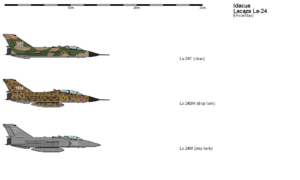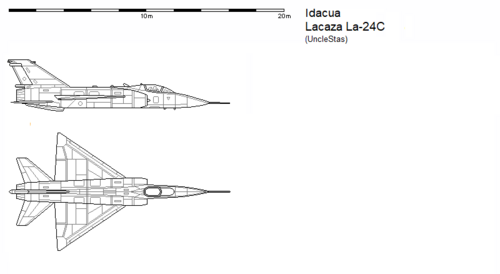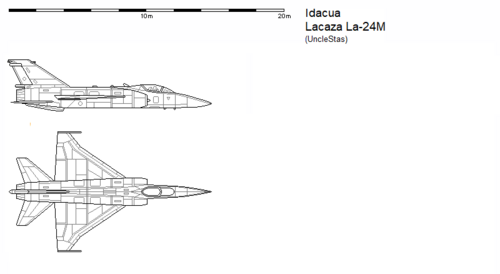Lacaza La-24 Halcón: Difference between revisions
No edit summary |
No edit summary |
||
| (14 intermediate revisions by the same user not shown) | |||
| Line 1: | Line 1: | ||
{{wip}} | {{wip}} | ||
{{Infobox Aircraft | {{Infobox Aircraft | ||
|name = | |name = Lacaza La-24 Halcón | ||
|type = {{wpl | Fighter aircraft| fighter}}, {{wpl | Multirole combat aircraft |Multirole Fighter}} | |type = {{wpl | Fighter aircraft| fighter}}, {{wpl | Multirole combat aircraft |Multirole Fighter}} | ||
|manufacturer = | |manufacturer = Lacaza Aircraft Design Office | ||
|image = File: | |image = File:La-24 variants template 1.png | ||
|caption = | |caption = La-24 variants | ||
|national origin = {{flag|Idacua}} | |national origin = {{flag|Idacua}} | ||
|first flight = 12 August | |first flight = 12 August 1981 | ||
|introduction = 23 May 1984 | |introduction = 23 May 1984 | ||
|retired = | |retired = | ||
| Line 18: | Line 18: | ||
}} | }} | ||
The ''' | The '''Lacaza La-24 Halcón''' (Sylvan: Falcon) is an Idacuan tail delta, single engine 4-generation generation air superiority multi-role all-weather tactical fighter developed by the Lacaza Aircraft Design Office. The La-24 entered service in 1984 mere months before the [[Marquez Junta]] took over the country. After the 1986 Revolution, the new government invested more in the aircraft and multiple variants have been created. The La-24 serves as one of Idacua's frontline fighters, and is offered for export. | ||
==Origins and development== | ==Origins and development== | ||
The Idacuan Air Force had been looking into developing its own jet fighter since the 1960s, but several projects were never fully realised and never surpassed prototype stage. Said prototypes were designs such as the the Moya AC.200 and AC.300 and the Ruiz I34, that, despite not giving Idacua its own fighter, granted designers and engineers experience in the craft. The Idacuan military continued to study designs that were purchased for the Idacuan Air Force, such as the [[Sieuxerr|Sieuxerrian]] Dassault Mirage III, as well as other foreign aircraft in air shows and presentations. The Mirages made a great impression to the Idacuans, who appreciated the advantages of the delta-wing design. | |||
In 1980, the Idacuan Ministry of Defence started a competition for a new fighter aircraft project. The aircraft needed to be single-engine, have one pilot and an empty weight of less than 10,000 kg, as well as be able to reach Mach 2. The main competitors were Moya Aeronautics, the Ruiz Corporation, as well as the smaller Lacaza Aircraft Design Office, headed by Simón Lacaza, a professor at the Guacara Technical University. Moya's prototype was a swept wing design similar to the [[Reberiya|Reberiyan]] VP-7DP-5, while Ruiz presented a compound delta wing design. The Moya fighter was deemed too heavy, almost reaching the 10,000 kg threshold, while the Ruiz project was speculated to be too unstable. Lacaza's fighter seemed to be inspired by both the Mirage III, particularly in the shape of its intakes, as well as the tailed delta of the [[Letnia|Letnian]] MiG-21, and was favoured by the Air Force's evaluation committee. Finally, the Lacaza design was chosen and the office was given athorisation and funding to build a prototype. | |||
==Design== | ==Design== | ||
===Airframe=== | ===Airframe=== | ||
The La-24's airframe is of the tailed delta wing design, which allows more stability than conventional delta wing designs. The design allows for great climb speeds, up to 285 m/s, however, as with all delta wings, extensive manuevers cause a sharp loss of speed. The La-24 operates with a fly-by-wire system. The aircraft uses retractable tricycle type landing gear, with small twin roadwheels on the front gear and single larger roadwheels on each of the main gears. A brake parachute is fitted on a compartment above the engine and can operate in conjuction with the aircraft's breaks. Efforts were made to include an integral, extendable refuelling probe, but it was found that the aircraft's nose was too small to fit the system. Instead, detatchable can be mounted on the nose on a special insert, depending on mission profile. | |||
===Engines=== | ===Engines=== | ||
The powerplant of the original La-24A was a Marcos A14 afterburning turbofan. However, it was found that the engine had several reliabitly problems, grounding many La-24As. After the 1986 Revolution, compatible engines were imported from Menghe to act as interim replacements until a repalcement was designed. The new engine, the IdaAvia MTP50, only arrived in 1989 and was included in the La-24C variant of the aircraft. The MTP50 was a more modular, simpler design, that was much easier for ground crews to work around. The definitive version of the engine, the IdAvia MTP50-M2, was introduced in late production La-24Ds and the latest La-24M variant, and the vast majority of La-24s in service is equipped with it. The MTP50-M2 is rated at 65 kN (15,000 lbf) in dry thrust and 95 kN (21,000 lbf) in afterburner. | |||
===Electronics and Avionics=== | ===Electronics and Avionics=== | ||
| Line 33: | Line 41: | ||
==Variants== | ==Variants== | ||
*''' | *'''La-24A:''' Initial production variant. | ||
*''' | *'''La-24B:''' Initial production two-seat trainer variant | ||
*''' | *'''La-24C:''' First post-Revolution variant, introduced in 1990. The upgrade features, among others, an added NCTR mode to the radar, as well as an upgraded engine. | ||
*''' | *'''La-24D:''' 2003 modernisation effort with a new TBD radar. | ||
*''' | *'''La-24BM:''' Upgraded two-seat operational conversion trainer with new avionics. | ||
*''' | *'''La-24M:''' 2013 upgrade featuring new TBD radar, modified wings with wingtip hardpoints, upgraded engine, as well as a 3rd generation targeting pod. | ||
*''' | *'''La-24E:''' Export variant offered since 1992 with TBD radar and TBD engine. | ||
*''' | *'''La-24EM:''' Upgraded export variant comparable to the R-284M. | ||
*''' | *'''La-24EB:''' Export variant of the La-24BM. | ||
==Specifications (La-24D/M)== | |||
[[File:Air Template La-24C side top.png|500px|right]] | |||
[[File:Air Template La-24BM side top 1.png|500px|right]] | |||
[[File:Air Template La-24M side top.png|500px|right]] | |||
{{aircraft specifications | {{aircraft specifications | ||
<!-- if you do not understand how to use this template, please ask at [[WT:Air]] --> | <!-- if you do not understand how to use this template, please ask at [[WT:Air]] --> | ||
| Line 82: | Line 92: | ||
|max speed alt= | |max speed alt= | ||
|max speed more= | |max speed more= | ||
|range main= | |range main= 1,550 km (837 nmi, 963 mi) with drop tanks | ||
|range alt= | |range alt= | ||
|range more= | |range more= | ||
|combat radius main= | |combat radius main= | ||
|combat radius alt= | |combat radius alt= | ||
|combat radius more= | |combat radius more= | ||
| Line 103: | Line 113: | ||
|guns= Provision for 2× 27 mm CR-127 cannon, 130 rounds per gun | |guns= Provision for 2× 27 mm CR-127 cannon, 130 rounds per gun | ||
|hardpoints= Total of 9: 4 under-wing, 4 under-fuselage, 1 centerline; with a capacity of 6,300 kg (13,900 lb) external fuel and ordnance (M variants have two additional wingtip hardpoints) | |hardpoints= Total of 9: 4 under-wing, 4 under-fuselage, 1 centerline; with a capacity of 6,300 kg (13,900 lb) external fuel and ordnance (M variants have two additional wingtip hardpoints) | ||
|hardpoint | |hardpoint missiles=<br /> | ||
**Air-to-air missiles: | **Air-to-air missiles: | ||
***[[YGG-5 Dando]] IR SRAAM | |||
***[[YGG-6]] SARH MRAAM | |||
***[[YGG-7 Hwasal]] ARH LRAAM | |||
***[[YGG-8]] IR MRAAM | |||
**Air-to-surface missiles | **Air-to-surface missiles | ||
***[[YGJ-42]] AGM | |||
|bombs=<br /> | ***[[YGJ-43]] ARM | ||
***[[YGJ-44]] ARM | |||
|hardpoint other= | ***[[YDH-28]] AShM | ||
|hardpoint bombs=<br /> | |||
***P-250 series | |||
***P-500 series | |||
|hardpoint other=<br /> | |||
***GHB-5/32 G rocket pod | |||
***GHB-8/20 G rocket pod | |||
***GHB-8/20 J rocket pod | |||
***Various fuel tanks | |||
<!-- Avionics --> | <!-- Avionics --> | ||
|avionics=TBA | |avionics=TBA | ||
}} | }} | ||
Latest revision as of 12:37, 8 October 2019
This article is incomplete because it is pending further input from participants, or it is a work-in-progress by one author. Please comment on this article's talk page to share your input, comments and questions. Note: To contribute to this article, you may need to seek help from the author(s) of this page. |
| Lacaza La-24 Halcón | |
|---|---|
 La-24 variants | |
| General information | |
| Type | fighter, Multirole Fighter |
| Manufacturer | Lacaza Aircraft Design Office |
| Status | In service |
| History | |
| Manufactured | 1978-2009 |
| Introduction date | 23 May 1984 |
The Lacaza La-24 Halcón (Sylvan: Falcon) is an Idacuan tail delta, single engine 4-generation generation air superiority multi-role all-weather tactical fighter developed by the Lacaza Aircraft Design Office. The La-24 entered service in 1984 mere months before the Marquez Junta took over the country. After the 1986 Revolution, the new government invested more in the aircraft and multiple variants have been created. The La-24 serves as one of Idacua's frontline fighters, and is offered for export.
Origins and development
The Idacuan Air Force had been looking into developing its own jet fighter since the 1960s, but several projects were never fully realised and never surpassed prototype stage. Said prototypes were designs such as the the Moya AC.200 and AC.300 and the Ruiz I34, that, despite not giving Idacua its own fighter, granted designers and engineers experience in the craft. The Idacuan military continued to study designs that were purchased for the Idacuan Air Force, such as the Sieuxerrian Dassault Mirage III, as well as other foreign aircraft in air shows and presentations. The Mirages made a great impression to the Idacuans, who appreciated the advantages of the delta-wing design.
In 1980, the Idacuan Ministry of Defence started a competition for a new fighter aircraft project. The aircraft needed to be single-engine, have one pilot and an empty weight of less than 10,000 kg, as well as be able to reach Mach 2. The main competitors were Moya Aeronautics, the Ruiz Corporation, as well as the smaller Lacaza Aircraft Design Office, headed by Simón Lacaza, a professor at the Guacara Technical University. Moya's prototype was a swept wing design similar to the Reberiyan VP-7DP-5, while Ruiz presented a compound delta wing design. The Moya fighter was deemed too heavy, almost reaching the 10,000 kg threshold, while the Ruiz project was speculated to be too unstable. Lacaza's fighter seemed to be inspired by both the Mirage III, particularly in the shape of its intakes, as well as the tailed delta of the Letnian MiG-21, and was favoured by the Air Force's evaluation committee. Finally, the Lacaza design was chosen and the office was given athorisation and funding to build a prototype.
Design
Airframe
The La-24's airframe is of the tailed delta wing design, which allows more stability than conventional delta wing designs. The design allows for great climb speeds, up to 285 m/s, however, as with all delta wings, extensive manuevers cause a sharp loss of speed. The La-24 operates with a fly-by-wire system. The aircraft uses retractable tricycle type landing gear, with small twin roadwheels on the front gear and single larger roadwheels on each of the main gears. A brake parachute is fitted on a compartment above the engine and can operate in conjuction with the aircraft's breaks. Efforts were made to include an integral, extendable refuelling probe, but it was found that the aircraft's nose was too small to fit the system. Instead, detatchable can be mounted on the nose on a special insert, depending on mission profile.
Engines
The powerplant of the original La-24A was a Marcos A14 afterburning turbofan. However, it was found that the engine had several reliabitly problems, grounding many La-24As. After the 1986 Revolution, compatible engines were imported from Menghe to act as interim replacements until a repalcement was designed. The new engine, the IdaAvia MTP50, only arrived in 1989 and was included in the La-24C variant of the aircraft. The MTP50 was a more modular, simpler design, that was much easier for ground crews to work around. The definitive version of the engine, the IdAvia MTP50-M2, was introduced in late production La-24Ds and the latest La-24M variant, and the vast majority of La-24s in service is equipped with it. The MTP50-M2 is rated at 65 kN (15,000 lbf) in dry thrust and 95 kN (21,000 lbf) in afterburner.
Electronics and Avionics
Operational history
Variants
- La-24A: Initial production variant.
- La-24B: Initial production two-seat trainer variant
- La-24C: First post-Revolution variant, introduced in 1990. The upgrade features, among others, an added NCTR mode to the radar, as well as an upgraded engine.
- La-24D: 2003 modernisation effort with a new TBD radar.
- La-24BM: Upgraded two-seat operational conversion trainer with new avionics.
- La-24M: 2013 upgrade featuring new TBD radar, modified wings with wingtip hardpoints, upgraded engine, as well as a 3rd generation targeting pod.
- La-24E: Export variant offered since 1992 with TBD radar and TBD engine.
- La-24EM: Upgraded export variant comparable to the R-284M.
- La-24EB: Export variant of the La-24BM.
Specifications (La-24D/M)
General characteristics
- Crew: 1: pilot
- Length: 15 m ()
- Wingspan: 8.40 m ()
- Height: 5.30 m ()
- Empty weight: 8,000 kg ()
- Loaded weight: 14,000 kg ()
- Max. takeoff weight: 19,200 kg ()
- Powerplant: 1 × IdaAvia MTP50-M2 afterburning turbofan
Performance
- Maximum speed: Mach 2.2 (2,336 km/h, 1,451 mph) at high altitude/ 1,110 km/h (690 mph) at low altitude
- Range: 1,550 km (837 nmi, 963 mi) with drop tanks ()
- Service ceiling: 17,060 m (59,000 ft) ()
- Rate of climb: 285 m/s (56,000 ft/min) ()
Armament
- Guns: Provision for 2× 27 mm CR-127 cannon, 130 rounds per gun
- Hardpoints: Total of 9: 4 under-wing, 4 under-fuselage, 1 centerline; with a capacity of 6,300 kg (13,900 lb) external fuel and ordnance (M variants have two additional wingtip hardpoints) and provisions to carry combinations of:
- Missiles:
- Air-to-air missiles:
- YGG-5 Dando IR SRAAM
- YGG-6 SARH MRAAM
- YGG-7 Hwasal ARH LRAAM
- YGG-8 IR MRAAM
- Air-to-surface missiles
- Bombs:
- P-250 series
- P-500 series
- Other:
- GHB-5/32 G rocket pod
- GHB-8/20 G rocket pod
- GHB-8/20 J rocket pod
- Various fuel tanks
- Missiles:
Avionics
TBA


